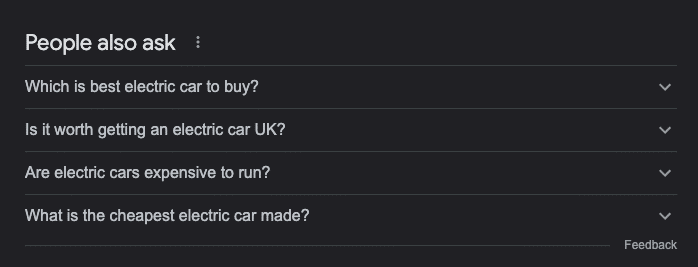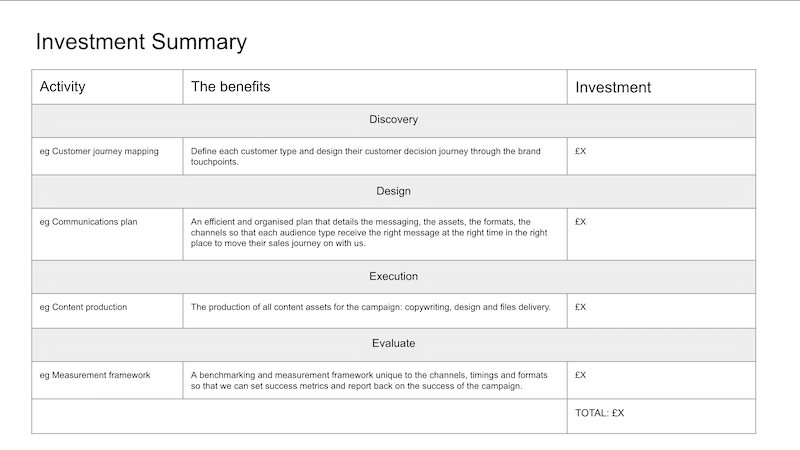

Presenting a marketing proposal is like putting a little bit of your soul out there for critique. When you show your thinking to a client, you want them to see themselves in the challenges you lay out and you want them to be excited by your ideas.
Ultimately, you want them to buy into it – literally. You want it to win.
Here’s a comprehensive, step-by-step guide to writing a strong marketing proposal – from the research and discovery phase to designing a strategy and writing a deck that sells ideas.
What is a marketing proposal?
A marketing proposal presents your suggested approach for successfully marketing a brand, product or service – that is, for raising awareness and persuading potential customers that the brand, product or service is worth buying.
Typically, a marketing proposal will detail how you, the marketer, propose to creatively capture the attention of a client’s potential customers in order to generate a certain amount of revenue. It will contain the strategy you propose to achieve this and an idea of timeline and costs.
Marketing proposals may be written for a couple of different types of audience. You’d write one for an external potential client if you work at an agency or as a freelance marketer. If you work in-house at a business, you might write one for internal stakeholders.
Either way, your goal is to persuade your audience to invest in your ideas – either hiring you or signing off on the budget. And in either case, the most important thing to remember is THE STORY. What story will you tell your audience so they agree with the vision and give sign-off to go ahead? How will you make them look at the challenge in a new way and offer a heroic solution?
A winning proposal will lay out a clear and concise story that sets the scene, introduces the problem, positions your ideas as the hero and shows a happy ending – the result they’ll get from buying your ideas. But how do you write your marketing proposal? Here’s everything you need to know.
All buying is an emotional decision
Even when the cash is coming from your company’s wallet and not your own, all buying decisions are emotional. People buy from people they like.
Even the most numerically minded stakeholders want to feel heard, engaged and, dare I say it, entertained by a marketing proposal. When you stand up and present your work, you’re putting on a show. And if you’ve done your job well, you’ll have your clients nodding along, agreeing with you and feeling good about the hour they’ve given to hear your proposal.
Your aim is to do as much as you can to make it impossible for your prospective clients to say no. You do this by really listening to what they want in the first place, and then designing a strategy and proposal that meet that explicitly.
ALWAYS present a proposal in person or over video rather than simply emailing it over. Presenting a marketing proposal helps turn the buying process into an emotional experience for the stakeholders. It will also allow you to answer questions, connect with your audience, build rapport, emphasise the parts you need to emphasise and show passion for the project.
In this guide, I’ll talk a lot about presenting a marketing proposal and how to create a winning deck that sells. But it’s worth noting you will need two versions of your proposal – one to present and one to send to your client that goes into more detail and can stand alone. The latter can be a document file or a modified version of your slide deck. I’ll talk more about this later.
Understand the problem you’re trying to solve
Before you start creating your marketing proposal, the first thing you need to do is understand the problem you’re trying to solve.
The discovery phase is crucial to designing a solution (and proposal) that your stakeholders will agree with and want to buy. There are many different ways you can do this. It will depend on how much you already know about the business, the budget and your access to data discovery tools like GWI (Global Web Index) that help you understand your consumers or a particular market.
But, generally, your discovery phase will involve the following stages:
- Interviewing your stakeholders (or those who briefed you)
- Understanding the challenges
- Uncovering insights
- Designing a strategy
Here’s a deep dive into each of these stages of discovery.
1. Interviewing stakeholders
The purpose of stakeholder interviews is to get information from the people who know the organisation best. The outcome of well-conducted stakeholder interviews should be that you uncover insights that will inform your solutions and shape your proposal.
Prepare a list of questions for your stakeholders. Make sure they’re all open-ended questions – that is, ones that prompt the interviewee to give detailed answers, rather than just a yes or no. Your aim is to better understand the business, marketing challenges, any nuances of their situation and their working culture.
Start with basic questions about the interviewee’s role and responsibilities so you understand who the senior decision-makers and influencers at the business are. Knowing this will help you later on when you’re positioning your proposal.
Use your interviews to work out what motivates your most senior decision-makers and always tailor your language to them. This is information you might already know if you’re creating an internal marketing proposal, so feel free to leave these questions out if they’re not needed.
After you’ve asked the basics, delve deeper into the marketing goals of the business, the organisational set-up and what the challenges have been so far. Do this with as many key stakeholders as you can.
Make sure to be an active participant in the interview, go off script and delve deeper into the issue if you think you can get a more thorough picture. Aim for each interview to be 30–45 minutes.
Here are some examples of stakeholder interview questions:
Basics and organisational questions
- What’s your job title and what are your main responsibilities?
- What team do you work on and who works closely with you on your team?
- When planning a marketing campaign, what are your key responsibilities?
- What goals are you trying to achieve as an individual or as a team?
- What would help you achieve those goals?
Marketing-related questions
- What do you think is working when it comes to marketing?
- What do you think can be improved?
- What are the main challenges?
- What goals are you trying to achieve as a business?
- What do you think your customers’ main barriers are to finding or loving your brand/product/service?
2. Understanding the challenge
You should end up with a few challenges or problems to solve after your stakeholder interviews. For example, a common theme may be an internal lack of marketing capability or a lack of resourcing. Perhaps there’s an external issue, like a competitor that’s taking the market share. Or maybe it’s more of a branding issue, like a lack of consumer awareness or a need for a refreshed market positioning.
Whatever you identify the main challenge to be, the next thing to do is fully research and understand it. And your stakeholders might not know this is the main challenge yet. So the aim when you are designing your marketing proposal is to make sure it frames this issue and gives evidence to support why this is the key issue to be solved.
If the challenge is a barrier such as a lack of consumer awareness, you might research why your target demographic is unable to find your product/service/brand. Or why they don’t like the product/service/brand. Or why they prefer another product/service/brand. Finding these things out will help you know what to propose to solve the challenge.
If customers don’t know the product/service/brand exists, you’d need to propose a marketing strategy to make it more findable. If customers don’t like the product/service/brand, your proposal will be built on ways to change this reputation, increase trust or communicate value. If customers prefer an alternative product/service/brand, your proposal might focus on how to position this one differently.
3. Uncovering insights
A good idea will never be anything more than that if you can’t prove why it’s good. Good insights support your ideas and justify them to your client, so your good ideas can be turned into action.
These insights might be universal truths relating to the product or service, they could come from data points, they could come from observing something from the market, or from your stakeholder interviews. Wherever they come from, good insights should make your stakeholders realise something new about the customer, the market or their product.
But how do you turn a finding or data set into an insight? It’s all about digging as deep as you can.
Here’s an example of how you uncover a key insight about your client’s market.
Let’s say your client is a car company who has just launched an electric car. They have sustainability goals they need to hit by 2030 and, ultimately, they need to sell their new model.
Your client supplies you with research documents about sustainability, including consumer research that reports 65% of car owners would buy an electric car.
You research how other car companies have marketed their electric models and you consume as much content about electric cars as you can. And you find that the majority of content about electric cars is confusing and includes a lot of technical language. Your client’s competitors are also not doing a great job of showing what electric cars are really like to own.
On a competitor’s YouTube channel, you notice a lot of negative comments saying that electric cars aren’t as good as traditional cars, with people also saying the infrastructure isn’t there yet to support electric cars.
This is a great insight on which to base your proposal: the market is making electric car ownership look hard and isn’t giving people educational content about electric models. So your proposal will be all about myth-busting and simplifying electric vehicle ownership.
Start with factual information, observe, and research to dig deeper and find the heart of the matter.
Fact: Your client needs to sell more electric cars to hit their sustainability targets.
Observation: People say they want to do the right thing for the planet.
Insight: People feel confused by electric cars and think owning them will be more hassle than owning a petrol car.
Here’s how to uncover killer marketing insights:
Research competitor brands – see what they’re doing well and not so well, and see where the opportunity is for your client. Your insight could be as simple as ‘Competitors are doing X, so we need to Y.’
See what real people are saying – observe comments sections on competitor content and look for themes. Search Google and see what comes up in the ‘People also ask’ section to get an idea for what people really want to know relating to the market.
Open image transcript
People also ask:
Which is best electric car to buy?
Is it worth getting an electric car UK?
Are electric cars expensive to run?
What is the cheapest electric car made?
4. Designing a strategy
Next you can begin to design your strategy. Using everything you’ve learned so far, decide what actions will help you achieve the client’s goals.
You’ll need to have an idea of the budget your client has so you can tailor your strategy to that. However, if you have ideas that may be outside the stated budget but that will help to hit the client’s goals, include those too. If your rationale is solid that they need to spend more to achieve the results they want, then it’s important to put these options on the table.
Your strategy should be a clear thread throughout your marketing proposal, from the title of your proposal to the way you position the context, the desired outcome and your ideas for how to achieve this.
Here’s a simple formula to help guide your strategic thinking:
1. Diagnosis
Take what you know from your stakeholders: their challenges, budget, timeline and the interview insights about the client’s company, marketing operations and ultimate business goals.
Add these to what you know from uncovering insights: the market context, what competitors are doing, and what people want from the product/service/brand.
2. Coherent actions
Consider what actions you can suggest that will help the client overcome their challenges and achieve their goals.
3. Measuring success
Decide what metrics you will use to know when you’ve delivered on the client goals. Make sure the metrics are clear and specific, so you and the client will know when you have achieved what you set out to achieve.
For example, if the marketing proposal covers how to raise awareness for a product/service/brand, work out what level of awareness is a satisfactory uplift and how to measure it.
The language to use
The language you use in a marketing proposal is key to its success. It should be simple and easy to read. Here are some tips:
-
- Avoid buzzwords, clichés and jargon. Even if you think the client is likely to understand a certain jargon word or phrase, don’t assume: find a simpler way of expressing what you’re saying. This is especially important if you’re writing and presenting in English and your client is not a native English speaker. Make sure the language you’re using is suited to your client.
- Make your headings sing. Make them big, bold statements showcasing your insights. This will have more impact than generic headings – or a lot of small text. Particularly when you’re presenting, you want your clients to be focusing on what you’re saying, not reading a lot of text on your slide.
- More formatting than language-related, but use bullet lists in the presentation slides and also in the more detailed version of the proposal. They help people process information quickly. (Here’s a list of compelling reasons why.)
How to write a marketing proposal
A good proposal is one that’s simple, quick to present and easy to understand. Make it crystal clear the value you’re bringing, what exactly you’re going to do, what that will achieve and how much it will cost.
A good deck sells ideas. The secret to a winning marketing proposal presentation is this: keep it clear, concise, persuasive, engaging and, crucially, brief. This is not War and Peace. Don’t make your stakeholders work hard to understand what you’re proposing.
For the presentation, use bulleted lists and bold statements rather than lots of running text whenever you can. Try to keep each section to as few slides as possible so the presentation is as punchy as it can be. Use your speaker notes so you can add the detail as you take your clients through your proposal.
Create two versions of your proposal: the deck to present and the version to send over afterwards. This is particularly important in case the proposal will be sent to other stakeholders who were not at the presentation: the document needs to be able to stand alone. After you’ve designed your strategy, it’s up to you whether you create the deck or the document version first.
You can either create an edited version of the deck to send (with the detail from the speaker notes added in) or a document version in Word or Google Docs (but send this as a PDF). The important thing is that this version is reader-focused and readable, so don’t try to cram too much text into the slide deck.
11 sections to structure a successful marketing proposal
There are 11 distinct sections a winning marketing proposal needs. This order provides a logical structure for your proposal, but it’s not totally set in stone. Move later sections around if you feel they need to be in a slightly different order. This is intended as a guide; all client challenges are different and require different narratives.
1. An enticing and snappy headline
Open strong on your title slide (or cover page for a document version). Not ‘Marketing proposal 2022’. Instead, think something more like ‘Supercharged marketing for 2022’, ‘Bolder, better, faster: a new content purpose’, or ‘Marketing that sells more – more often’.
2. The agenda and contents
This is essentially a contents page and can remain the same for the presentation deck and the document you email over afterwards.
When presenting, this slide can be the backdrop for your voiceover. It will outline what you’re going to show your audience, so they know what to expect. You should also set the outcome you all need by the end of the presentation: for example, to agree on next steps or schedule a second meeting. Or you can simply note that you’ll email over a detailed version and wait for their feedback.
For the version that you send to the client after the presentation, consider writing an executive summary to add in directly after the contents, so the reader can be reminded of the main beats of your proposal. (This is also vital for drawing in those readers who missed your presentation.)
3. Context
Set the context. ‘We are HERE (A) but want to get THERE (B).’
This is the section where you set the scene and ready your clients for the story you’re going to tell them. Here’s where you show you’ve done your research into their challenges and you demonstrate you’ve found out some truths and tease that you also have some answers.
Be honest about where the client is now. Uncomfortable truths are OK, as long as you have a rock-solid solution to get the client out of that uncomfortable place.
Truths might be quantitative data you have around how the current marketing strategy is failing to achieve the goals, or it could be qualitative data you’ve uncovered from stakeholders or by conducting market research.
This section might include information about the audience – your client’s demographic – to remind your clients who your ideas are for. A brief description of the audience, who they are and what they need from the product/service/brand is useful to ground the narrative and set the scene for your ideas.
For example, if you have a hospitality client in the food sector, you could mention that after lockdown during the Covid pandemic, many people were desperate to get out and enjoy life again. This insight into the client’s audience would help to ground the conversation and set the current context.
4. The challenge
Briefly highlight the challenge you’ve identified to get your clients nodding along with you. For the slide deck, a short bulleted list is good for this – add speaker notes to discuss nuanced detail and add further explanation during your presentation.
You might have identified the challenges through your research and/or stakeholder interviews. Make sure you always have evidence to support the challenges you present, such as quotes from the interviews, data points or observations about the market with screenshots of customer feedback.
Client challenges could be issues like:
- competitor brands have market share
- your client needs to launch a new product, but they currently don’t have a market for it
- your client’s current marketing strategy isn’t working.
5. The desired outcome
Your client will always be looking for a certain desired outcome, whether that’s brand advocacy or simply to sell more stuff. In this section, promise a specific outcome your client wants, cares deeply about and that you can deliver. Present this section as strong statements.
For example, start with a bold statement like: ‘Helping the UK fall in love with electric cars with educational, inspiring omnichannel content.’ Include:
- the opportunity: explain what the opportunity is and remind the client that time is short, to add pace and urgency
- the route to get there: briefly explain how you get from A to B.
6. Insights
Position your insights as new, important truths by giving them space to breathe in your presentation deck. Use large, bold statements that take up the majority of the slide and then talk your client through how you uncovered this insight.
In the version you send over later, use these bold statements as headings, and explain in running text (or bullet points) the detail you mentioned during the presentation.
For more tips on uncovering insights, go to the ‘Uncovering insights’ section, above.
7. Ideas
Whatever your insights are, here are the brilliant ideas that are going to transform insights into a solution that achieves your client’s goals. This section is where you do your Big Reveal. It’s where you should dazzle your client with your strategy for achieving their desired outcome.
You want your stakeholders to feel they can do something new and different. Something they haven’t tried and are excited by.
This will look different depending on your area of expertise and what kind of marketing activity you’ve identified as the answer to the challenge. For example, this section could be mainly visuals if you’re showing a creative treatment for a campaign, or it could be mainly words laying out a more strategic and tactical approach for how you’ll solve your client’s challenges.
At the end of this section, include the ideas and metrics you identified earlier for how to evaluate success.
8. Proof
This section says ‘Don’t believe we can do this? Here’s why we can.’
Here, draw on your experience, your integrity and significant times you have delivered similar outcomes before. Include a relevant case study with a compelling story that helps the client see themselves having the same success in the future.
9. Cost, deliverables and timeline
This section is dedicated to your client’s investment summary.
Make this section as easy to read as possible by using a table format that takes up one slide. List your deliverables and their costs in a column. If it’s possible to, set them against a timeline and add specific dates when the deliverable will be delivered. If you need more space, add an extra timeline slide after the investment summary and use a Gantt chart to list your deliverables against a timeline.
Make it clear what the scope of work is and what your role is. For example, will you be advising, consulting, or actually producing the work for them?
If the project is complex, or you haven’t worked out the timeline yet, you may want to split the deliverables into phases or workstreams, eg ‘The discovery phase’, ‘The design phase’, ‘The execution phase’ and ‘The evaluation phase’. List activities under each.
This is especially useful if you need to do further research and work before you decide what production will involve. For example, will you need to involve a data team, conduct customer research or do some testing and learning before designing a marketing campaign? If so, list these stages and activities clearly and price them individually.
Work out your costs based on who will be working on each activity, how long it will take them in days and what the day rate for each person is. If you’re not confident about defining pricing, work with your finance team on this part.
Here’s an example of how an investment summary table might look:
Click image to enlarge in new tab
Open description and transcript of image
Table labelled ‘Investment Summary’. The table has three column headings: ‘Activity’, ‘The benefits’ and ‘Investment’ and is further divided into the stages of the process: discovery, design, execution and evaluate.
The table is filled with some example text.
Under ‘Discovery’:
Activity: eg Customer journey mapping
The benefits: Define each customer type and design their customer decision journey through the brand touchpoints.
Investment: £X
Under ‘Design’:
Activity: eg Communications plan
The benefits: An efficient and organised plan that details the messaging, the assets, the formats, the channels so that each audience type receive the right message at the right time in the right place to move their sales journey on with us.
Investment: £X
Under ‘Execution’:
Activity: eg Content production
The benefits: The production of all content assets for the campaign: copywriting, design and files delivery.
Investment: £X
Under ‘Evaluate’:
Activity: eg Measurement framework
The benefits: A benchmarking and measurement framework unique to the channels, timings and formats so that we can set success metrics and report back on the success of the campaign.
Investment: £X
10. Recap
Always recap:
- This is the desired outcome.
- And this is how this idea is crucial for achieving it.
For example: ‘To make the UK fall in love with electric cars, we will design an omnichannel campaign that is both educational and inspirational to drive uptake and increase engagement for [BRAND].’
This is a final chance to dazzle your client with your great ideas before you invite feedback and discussion (or – in the write-up version – to end on a high).
Top tip: For the deck, make sure this is a good-looking visual slide and leave it on the screen during the feedback session.
11. Appendix
Your appendix should be any information that the client can look through in their own time that supports your proposal, but is not essential for the initial presentation.
Top tip: Anticipate the kinds of questions your client might have after they’ve seen your presentation, and include anything you might want to refer to during the discussion in the appendix. This might be a deep dive into your research findings or any data sets you have.
By adding it at the end, you can easily bring it up if needed.
Ideas of what to include:
- data / workings out
- the team that will work on the project
- additional relevant case studies
- your credentials, eg testimonials and client list
- the terms and conditions for doing business with you or your company.
Top tips for a winning marketing proposal
Are you raring to go with creating your next proposal? Just before you do, let’s recap some crucial tips for success.
Know your audience
This is vital to create an effective solution at all. But go further to frame your message in the most powerful way.
Identify your key decision-maker before the proposal presentation and tailor it to their needs and biggest pain points. Find out what makes them tick: for example, are they a numbers person, or more brand focused?
Based on this, design your lead message. So, if your chief decision-maker is numbers orientated, lead your proposal with what revenue figures you expect by following your plan. If they’re more brand focused, put what percentage uplift in brand metrics like engagement you expect.
Present, edit and email
I’ve said it already, but it’s worth repeating: always present a marketing proposal in person (or via a video call) so that potential clients are more likely to be persuaded to buy from you.
Keep the words on the slides when you present to a minimum so your client is paying attention to you, rather than reading the slides as you’re talking. Keep the detail in the speaker notes.
Then tailor a version to send afterwards, adding the details from your speaker notes before you formally email over the proposal. This is vital for persuading any stakeholders who were not present at the presentation, so they can still see how well you understand and can help them with their challenges and goals.
Invite feedback
When you present your marketing proposal, make sure you establish when you’ll be inviting feedback – will it be welcome throughout the presentation or should it wait until the end?
Sometimes clients can find it difficult to give feedback on the spot. They may prefer to do so after giving it all extra thought or consulting their wider team, so make sure you give them options.
When you email the deck after the presentation, make sure you are clear about when you need any more formal feedback, and follow up to either request this or acknowledge when it has been received.
Preparing to win
Marketing proposals are complex, and writing one can seem like a daunting task. But if you listen to your client, keep a strong sense of what story you want to tell and support that with insights, you’ll stay close to the challenges and create a concise, cohesive and persuasive proposal.
We hope you found this guide useful, and best of luck with your next proposal and presentation!
Interested in training your team to write better proposals? We can design a bespoke in-house course to help you hit your goals.
Main image credit: Mila Supinskaya Glashchenko / Shutterstock







